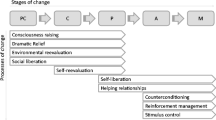Abstract
Individuals have the stated and unstated beliefs and intentions. The theory of planned behavior is expressed by the mathematical function where beliefs have empirically derived coefficients. However, personality traits can help account for differences in beliefs. In this paper, we will find out how we can amplify behavioral interventions from text-based trait insights. Therefore, we research techniques (e.g., sentence and word embedding) behind text-based traits. Furthermore, we exemplify text-based traits by 52 personality characteristics (35 dimensions and facets of Big Five, 12 needs and five values) and 42 consumption preferences via API of the IBM Watson™ Personality Insights service. Finally, we discuss the possibilities of behavioral interventions based on the personality characteristics and consumption preferences (i.e., text-based differences and similarities between the individuals).
Access this chapter
Tax calculation will be finalised at checkout
Purchases are for personal use only
Similar content being viewed by others
References
The International Organization for Standardization: ISO 5127:2017(en) Information and documentation — Foundation and vocabulary (2017). https://www.iso.org/obp/ui#iso:std:iso:5127:ed-2:v1:en
The European Union: The European Parliament or the Council Regulation (EU) 2016/679 of the European Parliament and of the Council of 27 April 2016 on the protection of natural persons with regard to the processing of personal data and on the free movement of such data, and repealing Directive 95/46/EC (General Data Protection Regulation) (2016). https://eur-lex.europa.eu/legal-content/EN/TXT/HTML/?uri=CELEX:32016R0679&from=EN
The International Organization for Standardization, the International Electrotechnical Commission: ISO/IEC 29100:2011(en) Information technology — Security techniques — Privacy framework (2011). http://standards.iso.org/ittf/PubliclyAvailableStandards/index.html
Bruce, P.: The Real Facebook Controversy. Data Science Central (2018). https://www.datasciencecentral.com/profiles/blogs/the-real-facebook-controversy
Ajzen, I.: Attitudes, Personality and Behavior. Open University Press, Maidenhead (2005)
IBM: API mashup guide (2017). https://www-01.ibm.com/common/ssi/cgi-bin/ssialias?htmlfid=LBS03048USEN
Gain, U., Hotti, V.: Tones and traits - experiments of text-based extractions with cognitive services. Finnish J. eHealth eWelfare 9(2–3), 82–94 (2017). https://doi.org/10.23996/fjhw.61001
IBM: Getting started tutorial (2018). https://console.bluemix.net/docs/services/personality-insights/getting-started.html#gettingStarted
Davis, T.: Sparse matrix algorithms and software (2018). http://faculty.cse.tamu.edu/davis/research.html
Ingersoll, K.: An Intro to Natural Language Processing in Python: Framing Text Classification in Familiar Terms (2018). https://www.datasciencecentral.com/profiles/blogs/an-intro-to-natural-language-processing-in-python-framing-text
Wikipedia: List of text corpora (2018). https://en.wikipedia.org/wiki/List_of_text_corpora
Turku NLP Group: Models (2018). http://bionlp-www.utu.fi/wv_demo/
Zeng, W., Luo, W., Fidler, S., Urtasun, R.: Efficient Summarization with Read-Again and Copy Mechanism (2017). https://arxiv.org/abs/1611.03382
Google: Neural Machine Translation (seq2seq) Tutorial (2018). https://www.tensorflow.org/tutorials/seq2seq
Pagliardini, M., Gupta, P., Jaggi, M.: Unsupervised Learning of Sentence Embeddings using Compositional n-Gram Features (2017). https://arxiv.org/pdf/1703.02507.pdf
Pennington, J., Socher, R., Manning C.D.: GloVe: Global Vectors for Word Representation (2014). https://www.aclweb.org/anthology/D14-1162
Google: word2vec (2013). https://code.google.com/archive/p/word2vec/
IBM: The science behind the service (2018). https://console.bluemix.net/docs/services/personality-insights/science.html#science
Pennington, J., Socher, R., Manning, C.D.: GloVe: Global Vectors for Word Representation (2014). https://nlp.stanford.edu/projects/glove/
Futusome: Services (2017). https://www.futusome.com/en/services/
GitHub: watson-developer-cloud/python-sdk (2018). https://github.com/watson-developer-cloud/python-sdk/tree/develop/examples
IBM: Personality Insights – API reference (2017). https://www.ibm.com/watson/developercloud/personality-insights/api/v3/?python
IBM: Personality models (2018). https://console.bluemix.net/docs/services/personality-insights/models.html#models
IBM: Needs (2017c). https://console.bluemix.net/docs/services/personality-insights/needs.html#needs
IBM: Values (2017d). https://console.bluemix.net/docs/services/personality-insights/values.html#values
IBM: Interpreting the numeric results (2018). https://console.bluemix.net/docs/services/personality-insights/numeric.html#numeric
IBM: Consumption preferences (2018). https://console.bluemix.net/docs/services/personality-insights/preferences.html#preferences
The Comprehensive R Archive Network: Hmisc: Harrell Miscellaneous (2018). https://CRAN.R-project.org/package=Hmisc
Johnson, J.: Measuring thirty facets of the five factor model with a 120-item public domain inventory: development of the IPIP-NEO-120. J. Res. Pers. 51, 78–89 (2014). https://doi.org/10.1016/j.jrp.2014.05.003
BiAffect: BiAffect (2017). http://www.biaffect.com/
Keras: The Python Deep Learning library (2018). https://keras.io/
TensorFlow: An open source machine learning framework for everyone (2019). https://www.tensorflow.org/
Wikipedia. Tensor (2018). https://en.wikipedia.org/wiki/Tensor
GitHub: EpistasisLab/tpot (2018). https://github.com/EpistasisLab/tpot
Author information
Authors and Affiliations
Corresponding author
Editor information
Editors and Affiliations
Appendices
Appendix A – Example of Big Five Traits and Facets of Them

Appendix B – Percentiles and Raw Scores for Personality Characteristics


Appendix C – Consumption Preferences

Rights and permissions
Copyright information
© 2018 Springer Nature Switzerland AG
About this paper
Cite this paper
Gain, U., Koponen, M., Hotti, V. (2018). Behavioral Interventions from Trait Insights. In: Li, H., Pálsdóttir, Á., Trill, R., Suomi, R., Amelina, Y. (eds) Well-Being in the Information Society. Fighting Inequalities. WIS 2018. Communications in Computer and Information Science, vol 907. Springer, Cham. https://doi.org/10.1007/978-3-319-97931-1_2
Download citation
DOI: https://doi.org/10.1007/978-3-319-97931-1_2
Published:
Publisher Name: Springer, Cham
Print ISBN: 978-3-319-97930-4
Online ISBN: 978-3-319-97931-1
eBook Packages: Computer ScienceComputer Science (R0)




